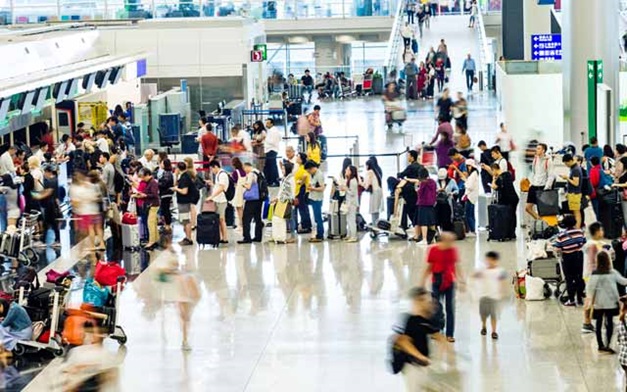Managing migration
With ever-evolving policy, the changes brought on by Brexit and impassioned tabloid headlines, migration in all its forms is a hot topic that is never far from the public consciousness. But what’s the truth behind the front pages? Can migration be managed in a way that is beneficial to all?
These are the questions that fascinate Dr Zovanga Kone, lecturer in Economics at the University of Leicester School of Business. His research, which was further enhanced by time spent working at COMPAS, the University of Oxford's Centre on Migration, Policy and Society, centres on several key themes that shape our understanding of migration.
Documenting migration
The patterns of migration to the UK in recent years tracks closely to broader political and economic developments. From 13,000 in 1992, migration continued to rise, with peaks and troughs along the way following developments such as EU expansion, changing government policy and the effects of the 2007 economic crisis. Since hitting a peak in 2014-2015, migration to the UK has now started to fall.
As a student, Dr Kone grew interested in the different outcomes he noted between first- and second-generation immigrants. Keen to formalise his observations, he quickly found not only a lack of existing studies on the subject, but also that the data informing the limited research was too poor to allow any firm conclusions to be drawn in the context of the UK. With several of the existing studies using proxy measures, such as combining age and ethnicity to assume which generation an individual belongs to, previous research has confused and amalgamated second generation migrants with those classed as native – those born to second generation immigrants – and vice versa. Dr Kone’s work warns that such amalgamation renders the findings uninformative and urges taking great care to source data that better reflects the migrant experience in the UK.

Migration is an integral part of our species; humans have been migrating for millennia and will continue to do so. Understanding migration better - by starting to know the facts about migration - and harnessing its benefits can only be to our advantage.
Introducing policy
Around the world, countries take very different approaches to economic migration. From systems such as in Australia, which enforces strict criteria through a points-based system that prioritises certain professions, to the European Union’s freedom of movement, there are myriad ways to control the movement of workers.
Controlling migration through visas prioritises certain jobs, and these roles remain tied to the employer. These immigration policies aim to attract target individuals with the specific skills required to fill labour gaps. Dr Kone questions how effective these policies are and whether any such system is worth the cost and effort of implementation; he seeks to answer if a country would attract migrants with the desired skills and concurrently fill labour gaps with laxed visa policies.
In 2004, the UK was one of three countries – and the largest economy – to allow freedom of movement without visas to workers from the newly-joined European Union (EU) member states, with other countries implementing temporary immigration controls. This difference in approach did not result in a significant change in the skill of arriving migrants, though there was a difference in the jobs they were taking compared with previous arrivals from the new member states. Although there was little difference in wages between visa and non-visa migrants, those requiring visas were concentrated in London and the South East, whilst non-visa migrants were regionally dispersed around the UK – arguably moving to take up employment opportunities and boosting regional economies in return.
Since the EU referendum in 2016 and Britain’s subsequent withdrawal in 2020, some employers have reported shortages of low-skilled workers in sectors such as agriculture and hospitality, who would have traditionally been recruited from the EU, demonstrating the advantages of allowing migrants into the country and to then move freely. This effect was further compounded during the COVID-19 pandemic, when jobs required ‘on site’ such as construction or cleaning experienced an unanticipated shock following the restrictions designed to halt the spread of the virus. Dr Kone believes this proves that more relaxed visa policies are required to allow movement without costly administrative hurdles.
The refugee experience
An area of particular interest to Dr Kone is the difference in migrants’ experiences, based on how they came to migrate to the UK. With just over 132,000 refugees in the UK (UNHCR 2020), this small but significant group have different needs to those migrating for economic reasons. Dr Kone – with co-authors at the University of Oxford – is exploring the health outcomes of refugees, comparing across different levels of integration and inclusion against those arriving in the UK for work or study.
With many refugees arriving in their host countries with a high standard of education and professional experience, integrating these individuals into the workplace offers many benefits for the host countries. Motivated to learn English quickly to enable them to convert their skills, refugees may provide overall benefits to the labour market, but they are more likely to rely on job centres to find work than other groups, who mostly rely on other methods such as social networks and direct application to employers . Dr Kone researches different methods of job searching for refugees, comparing them with other migrant groups and natives.
Brain drain or brain gain?
Turning his attention to the movement of highly skilled workers, Dr Kone documents the effect of migration on migrants’ home countries. It is often feared that migration will result in a ‘brain drain’, where certain sectors lose highly skilled staff to meet demand in countries with higher wages and better opportunities, leaving a skills gap. In his on-going research looking at medical physicians, Dr Kone has revealed that actually the opposite is true – in witnessing the success of previous migrants, more people are motivated to acquire skills in the hope of realising similar opportunities in the majority of countries across the globe. Having acquired skills with an initial hope of migrating, migration only materialises for relatively few people as the number of opportunities for migration does not increase in line with the number of suitable candidates, and so the incentive of migration increases the number of highly skilled workers in home countries.
An option for all?
With clear benefits of migrating, would we see unlimited migration if policy wasn’t in place?
Dr Kone – with co-authors from the World Bank – has conducted research into the situation in India, where the states that make up the country could be considered pseudo-countries in terms of their sizes and scope of local decision-making. Although individuals are free to move between states to take advantage of higher salaries and better opportunities than available locally, Dr Kone’s work found that migration between states isn’t common. So what restricts workers? The invisible ties and social benefits of staying close to home outweigh the benefits of moving for many when combined with uncertainty about future opportunities making the long-term benefits harder to judge.
At the global level, international migration flows are dominated by regional migration with most migrants moving to neighbouring countries. Even then, interesting patterns emerge in the data. ECOWAS, the Economic Community of West African States, is one of the largest regional unions in Africa that allows free movement of persons between member states. Yet, with the exception of the Ivory Coast, the share of migrants from other member states in the total population is relatively small in any given country, with migrants with a parental tie to the country accounting for a large share of the foreign-born population in some countries.





